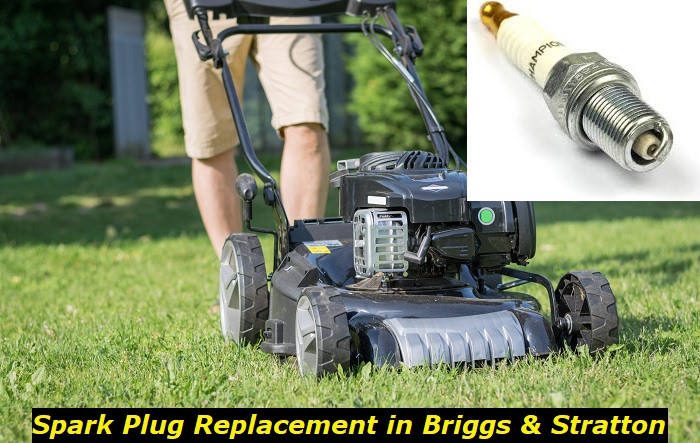Briggs and Stratton Spark Plug Replacement: When Needed and How to Do?
The spark plug is a crucial component of any internal combustion engine, and the engines that power lawnmowers are no exception, despite their smaller size. In this article, we'll guide you through simple DIY steps to troubleshoot, remove, clean, and replace the spark plug in your Briggs & Stratton lawn mower.
The spark plug delivers the essential electric spark required to ignite the fuel-air mixture in the engine, allowing it to run. A malfunctioning spark plug could prevent the engine from starting. Conversely, an improperly functioning spark plug might not deliver the correct amount of electric "fire" in the combustion chamber, resulting in insufficient power for optimal lawn mower operation.

Thus, understanding how to troubleshoot, check, and change the spark plug in your Briggs & Stratton lawn mower is essential for owners. Mastering the process of detecting issues, examining, cleaning, and replacing a spark plug is a must.
If your Briggs & Stratton lawn mower engine hasn't been serviced recently, you may encounter issues such as:
· Difficulty starting or complete failure to start,
· Lack of smooth operation, or
· Excessive fuel consumption.
These problems are often attributable to a dirty or damaged spark plug. Clean and sharp spark plug electrodes are necessary to produce a strong electric spark that ignites the air/fuel mixture. This spark must occur reliably whenever the engine runs.
Fortunately for lawn mower owners, spark plugs are both easy to service and relatively inexpensive to replace.
When Should You Change the Spark Plug?
Briggs & Stratton recommends changing the spark plug every 100 hours of operation or at the end of every mowing season, whichever comes first. Regularly changing the spark plug is essential for:
· Dependable engine start-up,
· Consistent electric spark production,
· Enhanced fuel economy,
· Optimum engine performance.
However, there may be situations that necessitate a spark plug change sooner than the 100 hours or season's end, such as malfunction or noticeable performance drops.
Continuous use will age a spark plug, leading to wear and tear along with other issues that diminish its efficiency. The electrode edges at the center and ground can wear down, increasing the gap and, consequently, the voltage required to bridge it for ignition. The engine's ignition system may struggle to supply the needed voltage, leading to unburned fuel in the combustion chamber.
To maintain the necessary powerful electric discharge for ignition, spark plug electrodes must remain clean and sharp. If they become dirty or dull, the engine must work harder to generate the high voltage required.
Determining whether a spark plug is malfunctioning is relatively straightforward. Beyond the obvious symptoms such as starting failures, engine misfires, abnormal fuel consumption, or excessive smoke, a physical inspection can reveal much about a plug's condition. To evaluate the spark plug, it must be removed from the engine.
1) Removing the Plug
To extract the spark plug:
- · Begin by disconnecting the spark plug lead. Clean the area around the spark plug meticulously to prevent any debris from entering the engine upon plug removal.
- · Employ a spark plug socket to unscrew and remove the plug.
- · Examine the plug for any signs of physical damage, such as cracks, discoloration, stubborn deposits, eroded gaps, or burned electrodes.
- · For the correct spark plug gap (the distance between the curved and straight electrodes), use a spark plug gap gauge to measure and adjust as necessary.
2) Troubleshooting
- · A light tan or gray color on the spark plug's firing end suggests optimal operation.
- · A dark or blackened firing end indicates poor condition and potential over-fueling or a rich fuel mixture.
- · Fuel, carbon, or oil deposits on the plug's insulator indicate fouling, which impedes the proper flow of voltage and diminishes the spark's strength, warranting replacement.
- · Wet deposits might suggest severe internal engine issues, such as a cracked head gasket or worn rings and valves, rather than a plug issue alone.
- · Eroded electrodes or heavy deposits suggest insufficient sparking and necessitate plug replacement.
- · Any signs of cracked porcelain or insulator damage are indications that the spark plug is defective and should be replaced.
A failing spark plug can lead to additional engine problems, including power loss, increased inefficiency, heightened fuel consumption, oil dilution, and deposit accumulation within the engine's cylinder head. Your observations will dictate whether you should clean the plug or replace it altogether.
3) Cleaning
- · For light deposits, use a wire brush or spark plug cleaner spray. Avoid using a shot blaster or abrasive materials, as these can damage the plug.
- · Scrape off any stubborn contaminants with a sturdy knife.
- · If the spark gap does not match the manufacturer's recommendation, carefully bend the curved electrode with a spark plug gap tool. The typical gap is 0.30 inches, but always check the user manual for the correct specifications for your specific model.
Selecting the correct spark plug for your engine is paramount. The suitable spark plug is determined by several factors, including thread diameter, thread reach, insulator nose projection, nose shape, and whether it incorporates a gasket. Due to variances in engine designs, the operator's manual should be your primary reference for recommended spark plugs.
If the manual is unavailable, the manufacturer's website can be a valuable resource. Alternatively, seeking advice from a mechanic with experience in your engine type is advisable. Although multiple plugs may fit, using the manufacturer-recommended type is essential to prevent engine damage.
Briggs & Stratton recommend specific spark plug models for their lawnmowers, such as the Platinum series (part numbers 796560, 5062, 5062D, 5062H), as well as Champion models J19LM, CJ8, RJ19LM, RCJ8, and RJ19HX. These have a standardized gap of 0.30 inches. For Quantum series engines, the Champion RJ2YLE is recommended, and the "Surefire" RJ2YXLE for Craftsman Smooth Start engines. Always match the spark plug to your engine model or number as indicated in the operator manual.
4) Re-installing the Plug
Once the plug is cleaned or you've obtained a replacement:
- · Reinstall the plug, taking care not to over-tighten (a maximum of 15 ft. lbs. is recommended).
- · Reattach the spark plug lead, then attempt to start the engine. A normal start-up indicates no other issues are present. If the engine attempts to start, the spark is likely effective, and troubleshooting may be required elsewhere.
- · A new spark plug can revitalize ignition efficiency, engine power, and fuel economy while reducing misfires and exhaust emissions. Addressing spark plug issues promptly is crucial to prevent further engine damage and maintain performance.
Final Thoughts
The maintenance of spark plugs is essential for the optimal performance of your lawn mower. Regular tuning, maintenance, and replacement are vital at the start and end of the mowing season or after extended storage.
Consider investing in a Briggs & Stratton tune-up kit, which includes essential maintenance items such as oil filters, spark plugs, air filters, and fluids like oil and fuel stabilizers. Such a kit is invaluable for keeping your equipment in prime condition.

Add comment